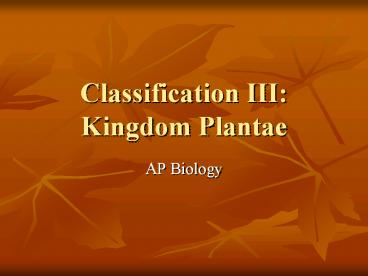Classification III: Kingdom Plantae - PowerPoint PPT Presentation
1 / 27
Title: Classification III: Kingdom Plantae
1
Classification IIIKingdom Plantae
- AP Biology
2
Kingdom Plantae
- Plants had to adapt to life outside water to
prevent drying out, still allow gametes to
travel, and prevent UV radiation damage - Dipoid sporophyte generation 2 copies of each
chromosome allow recessive mutations to be masked - Cuticle waxy covering to prevent dessication
- Vascular system water distribution throughout
the plant, later xylem for water phloem for
food - Pollen gametes packaged for easy delivery
- Ovary protection for gametophytes
- Seasonal variation deciduous and desert annuals
3
Phylum 1. Bryophyta
- Mosses, liverworts, hornworts
- Produce haploid spores via meiosis (wind borne)
- Lack vascular system
- No true roots, true stems, or true leaves
- Remain small
- Water must be available for absorption through
surface tissues and as a transport medium for
sperm (flagellated)
4
Bryophyta
5
Tracheophytes (vascular plants)
- The next divisions are vascular plants
- Possess xylem and phloem
- Have true roots, stems and leaves
- In first 3 Lycophyta, Sphenophyta, Pterophyta
- Produce flagellated sperm which swim to fertilize
the eggs - Diploid zygote produced, which grows in to the
sporophyte
6
Phylum 2. Lycophyta
- 2 Groups
- 1. Now extinct woody trees common in
Carboniferous period (300 mya) - 2. Tropical epiphytes (plants that live on other
plants) and small herbaceous plants (club mosses)
7
Phylum 3. Sphenophyta
- Extinct woody trees common during Carboniferous
period - Horsetails
- Hollow, ribbed stems that are jointed at nodes
- Nodes produce small scale-like leaves and
sometimes branches - Bushy branches give the appearance of a horsetail
- Stems, branches and leaves are green and
photosynthetic
8
Sphenophyta
9
Phylum 4. Pterophyta
- Ferns
- Clusters of sporangia called sori develop on the
undersurface of fern fronds - Sporangia undergo meiosis and produce spores
10
Seed Plants
- Two kinds of spores produced male female
- Microsporangia produce microspores (male)
- Macrosporangia produce macrospores (female)
- Microspores produce 4 haploid cells that mature
into pollen - Megaspores produce 1 surviving haploid megaspore
which becomes 1 egg (flowering plants) or 2 eggs
(conifers) - When pollen contacts the megasporangium, a tube
directs the pollen to the egg
11
Phylum 5. Coniferophyta
- Conifers (cone-bearing) pines, firs, spruce,
junipers, redwoods, cedars, and others - Male and female reproductive structures are in
pollen-bearing male cones and ovule-bearing
female cones - Gymnosperms naked seeds
- Fertilization and seed development is lengthy,
requiring 1-3 years
12
Conifers
13
Phylum 6. Anthophyta
- Angiosperms (flowering plants)
- Parts of the flower
- Carpel (or pistil) female reproductive structure
- Ovary, Style, Stigma
- Stamen male reproductive structure
- Anther (pollen-bearing), Filament (stalk)
- Petals sometime Sepals function to attract
pollinators
14
(No Transcript)
15
Angiosperm Flowers
- The flower is a major evolutionary advancement
- Special adaptation to attract pollinators
- Ovules are protected inside an ovary
- Ovary develops into a fruit which fosters the
dispersal of seeds by wind, insects, birds,
mammals, and other animals
16
Angiosperm Fertilization
- Pollen lands on sticky stigma
- Pollen tube grows down style toward ovule
- 2 sperm cells inside the pollen tube
- 1 diploid nucleus formed, and 1 triploid nucleus
formed (becomes endosperm) this is called double
fertilization - Endosperm provides nourishment for embryo and
seedling
17
Angiosperms
- Additional advancements
- More specialized vascular tissues
- Numerous variations in habit and growth
- Result advanced survival ability in a variety of
environmental conditions
18
Kingdom Plantae
19
Angiosperm Groups
- Divided into monocots dicots
20
Plant Tissues
- Ground Tissues
- Parenchyma cells storage, photosynthesis,
secretion - Collenchyma cells mechanical support
- Sclerenchyma cells also mechanical support
- Dermal Tissue
- Epidermis cells secrete waxy cuticle
- Vascular Tissue
- Xylem conducts water/minerals
- Phloem conducts sugar/starches produced in
photosynthesis
21
Roots and Shoots
- Most growth occurs at the tips of roots and
shoots - Apical meristems area of primary growth
- Primary growth gives plants height, length in
roots at apical meristems - Secondary growth widens plant girth
22
Monocot Root
23
Dicot Root
24
Monocot Stem
25
Dicot Stem
26
Leaves
27
Cohesion-Tension Theory






























